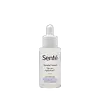What's inside
What's inside
 Key Ingredients
Key Ingredients

No key ingredients
 Benefits
Benefits

 Concerns
Concerns

No concerns
 Ingredients Side-by-side
Ingredients Side-by-side

Water
Skin ConditioningAcetamidoethoxyethanol
HumectantGlycerin
HumectantPanthenol
Skin ConditioningHeparan Sulfate
Skin ConditioningPolyacrylate Crosspolymer-6
Emulsion StabilisingSodium PCA
HumectantHydroxyacetophenone
Antioxidant1,2-Hexanediol
Skin ConditioningCaprylyl Glycol
EmollientErythritol
HumectantCarrageenan
Pentylene Glycol
Skin ConditioningBiosaccharide Gum-1
HumectantSodium Carboxymethyl Beta-Glucan
CleansingSodium Acetylated Hyaluronate
HumectantSodium Hyaluronate
HumectantSodium Hydroxide
BufferingSodium Hyaluronate Crosspolymer
HumectantSodium Anisate
AntimicrobialHydrolyzed Sodium Hyaluronate
Skin ConditioningSodium Levulinate
Skin ConditioningCitric Acid
BufferingBenzoic Acid
MaskingXanthan Gum
EmulsifyingGlyceryl Caprylate
EmollientSorbic Acid
PreservativeDisodium EDTA
Ethylhexylglycerin
Skin ConditioningWater, Acetamidoethoxyethanol, Glycerin, Panthenol, Heparan Sulfate, Polyacrylate Crosspolymer-6, Sodium PCA, Hydroxyacetophenone, 1,2-Hexanediol, Caprylyl Glycol, Erythritol, Carrageenan, Pentylene Glycol, Biosaccharide Gum-1, Sodium Carboxymethyl Beta-Glucan, Sodium Acetylated Hyaluronate, Sodium Hyaluronate, Sodium Hydroxide, Sodium Hyaluronate Crosspolymer, Sodium Anisate, Hydrolyzed Sodium Hyaluronate, Sodium Levulinate, Citric Acid, Benzoic Acid, Xanthan Gum, Glyceryl Caprylate, Sorbic Acid, Disodium EDTA, Ethylhexylglycerin
 Reviews
Reviews

Ingredients Explained
These ingredients are found in both products.
Ingredients higher up in an ingredient list are typically present in a larger amount.
1,2-Hexanediol is a synthetic liquid and another multi-functional powerhouse.
It is a:
- Humectant, drawing moisture into the skin
- Emollient, helping to soften skin
- Solvent, dispersing and stabilizing formulas
- Preservative booster, enhancing the antimicrobial activity of other preservatives
Ethylhexylglycerin (we can't pronounce this either) is commonly used as a preservative and skin softener. It is derived from glyceryl.
You might see Ethylhexylglycerin often paired with other preservatives such as phenoxyethanol. Ethylhexylglycerin has been found to increase the effectiveness of these other preservatives.
Glycerin is already naturally found in your skin. It helps moisturize and protect your skin.
A study from 2016 found glycerin to be more effective as a humectant than AHAs and hyaluronic acid.
As a humectant, it helps the skin stay hydrated by pulling moisture to your skin. The low molecular weight of glycerin allows it to pull moisture into the deeper layers of your skin.
Hydrated skin improves your skin barrier; Your skin barrier helps protect against irritants and bacteria.
Glycerin has also been found to have antimicrobial and antiviral properties. Due to these properties, glycerin is often used in wound and burn treatments.
In cosmetics, glycerin is usually derived from plants such as soybean or palm. However, it can also be sourced from animals, such as tallow or animal fat.
This ingredient is organic, colorless, odorless, and non-toxic.
Glycerin is the name for this ingredient in American English. British English uses Glycerol/Glycerine.
Learn more about GlycerinWater. It's the most common cosmetic ingredient of all. You'll usually see it at the top of ingredient lists, meaning that it makes up the largest part of the product.
So why is it so popular? Water most often acts as a solvent - this means that it helps dissolve other ingredients into the formulation.
You'll also recognize water as that liquid we all need to stay alive. If you see this, drink a glass of water. Stay hydrated!
Learn more about Water